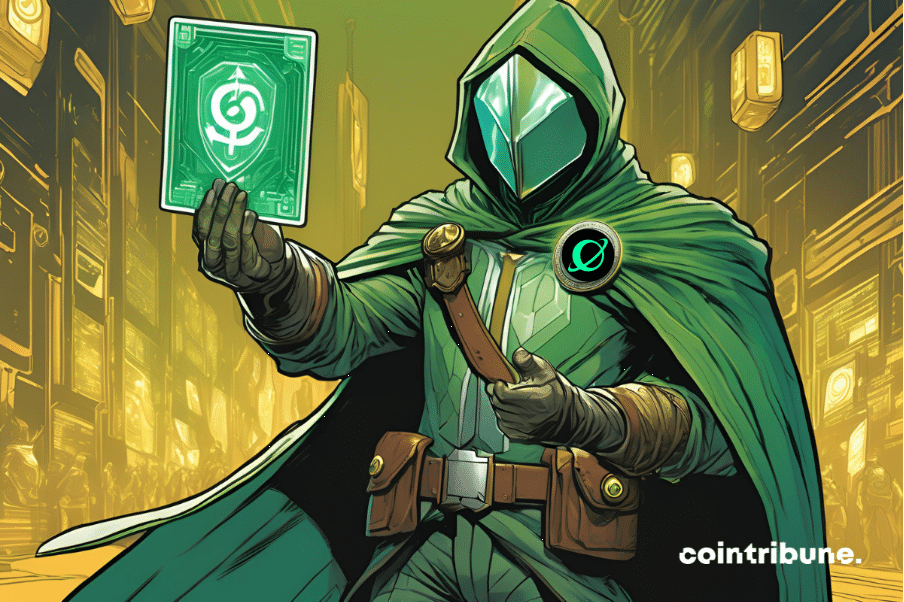Why Invest in Cybersecurity Cryptocurrencies?
The cryptocurrency market continues to attract a growing number of investors seeking innovation and returns. Yet, each new attack or exploited vulnerability highlights the fragility of the ecosystem. Security remains a non-negotiable condition for sustaining trust and enabling mass adoption. A new vertical is emerging in response to these challenges: cybersecurity cryptocurrencies. These assets combine utility, resilience, and direct responses to the structural weaknesses of Web3. Among them, Naoris Protocol stands out for its infrastructure-first, decentralized, and post-quantum approach. This article explores current market risks, the importance of native security, and Naoris’s strategic role in this transformation.

In Brief
- The crypto market remains highly exposed to attacks, scams, and quantum threats, making security a core investment priority.
- Naoris Protocol introduces a post-quantum, decentralized infrastructure that validates every action and device in real time.
- Its Sub-Zero Layer, dPoSec, Swarm AI, and quantum-proof cryptography secure both Web2 and Web3 without disrupting existing systems.
- Naoris is the first protocol to run post-quantum transactions in production, with over 133 million validated and 1.1 million nodes.
- The $NAORIS token drives a security-based economy, rewarding validated actions and powering Cybersecurity-as-a-Service (CSaaS).
- Backed by strategic partners, Naoris offers early exposure to a fast-growing sector where security is becoming the foundation of trust.
An attractive but exposed market: crypto’s structural weaknesses
The crypto space is appealing due to its return potential, pace of innovation, and global accessibility. But beneath this promise lies a landscape still vulnerable to deep flaws. These weaknesses directly threaten investors and slow institutional adoption.
Widespread threats to investors
Attacks on digital assets are increasing. Many centralized exchanges have suffered major hacks, resulting in billions of dollars in losses. Unsecured wallets are easy entry points for hackers. Smart contracts, often unverified or poorly written, contain exploitable bugs. Attacks like The DAO or Wormhole have exposed the ecosystem’s inability to protect itself continuously.
In addition, scams like rug pulls and fake projects thrive. The absence of clear governance, traceability, and enforcement encourages market manipulation. In this environment, no cryptographic validation certifies protocol integrity in real time. The market operates without a global safety net.
Volatility amplified by lack of trust
Each attack triggers a domino effect. Users sell out of fear, institutions freeze initiatives, and liquidity dries up. Panic becomes a volatility amplifier. The lack of structural security worsens market fluctuations. Trust becomes a tangible asset. When trust vanishes, value plummets. When it’s established, capital flows in.
Today, the market increasingly rewards projects that can prove their security, not just those that innovate. In this context, cybersecurity-focused cryptocurrencies offer a clear answer: turning security into measurable value.
Cybersecurity: a prerequisite for mass adoption
Crypto market growth depends on a frequently overlooked factor: trust. Without verifiable security, investors hesitate, institutions withdraw, and users churn. Cybersecurity becomes a structural necessity for ecosystem expansion.
Trust: a key driver of capital flow
Regulators are imposing increasingly strict standards on resilience. Institutional players demand technical guarantees before committing long-term capital. A crypto project can no longer rely on a whitepaper and hype. It must demonstrate that its infrastructure protects assets, data, and users.
Perceived security directly impacts liquidity and stability. Capital flows to platforms where risks are limited, known, and managed. In this context, classical security models—centralized, manual, and occasional, are no longer enough. A native, distributed, and cryptographically proven approach is required.
Securing the foundations of Web3
Web3 is built on the promise of decentralization, yet its technical foundations remain fragile. DEXs, DAOs, bridges, and NFTs depend on scripts and servers still rooted in Web2. Each vulnerability compromises the network’s overall integrity.
Audits, while necessary, are periodic and don’t catch dynamic or unpredictable attacks. The solution lies in continuous, architecture-level validation, capable of detecting anomalies in real time. Security must become a distributed cryptographic mesh across all layers.
Preparing for the Q-Day
The quantum tsunami isn’t approaching, it’s already washing over the shore. ‘Q-Day isn’t a distant theoretical concern, it’s a ticking time bomb set to detonate in the immediate future,’ declares Professor Hiroshi Takano of Quantum Security Research. ‘Every significant metric we track has been shattered in recent months. What we thought would take five years is now measurable in months.’
Projects like Willow, Majorana, and Zuchongzhi 3 have made explosive, classified breakthroughs that intelligence agencies confirm are far closer to breaking classical cryptographic standards than publicly acknowledged.
The moment when quantum machines can break RSA or ECC, the dreaded Q-Day, now looms as an immediate existential threat, with most blockchains completely unprepared for what could happen before the end of 2025. This represents not just a strategic gap, but a catastrophic security abyss that threatens to swallow the entire crypto ecosystem virtually overnight.
Investors now seek projects designed from the ground up to withstand this threat. This foresight is becoming a competitive advantage and cybersecurity cryptocurrencies that anticipate this shift are drawing attention from the most informed capital.
Naoris Protocol: a post-quantum cybersecurity infrastructure
Naoris Protocol is not just another security tool ; it redefines digital infrastructure by putting trust and validation at its core. Its decentralized, post-quantum architecture adapts to both Web2 and blockchain ecosystems.
The Sub-Zero Layer: native, invisible, and seamless security
The Sub-Zero Layer operates beneath Layers 0, 1, and 2. It acts as a universal security foundation, without disrupting existing networks. It ensures real-time validation of every device, node, and transaction. It detects and isolates suspicious behavior without relying on centralized actors.
Naoris also integrates with Web2 infrastructures, linking cloud, IoT, edge, and blockchain environments into a global Trust Mesh, without the need for hard forks or complex migrations.
dPoSec, Swarm AI, and Post-Quantum cryptography
Naoris is built on three core technologies:
- dPoSec (Decentralized Proof of Security) turns every device into an active validation node. It continuously checks device integrity in a non-hierarchical, distributed way;
- Swarm AI coordinates threat responses across the network. It learns from each attack and distributes countermeasures instantly;
- The protocol uses post-quantum algorithms like Dilithium-5, compliant with NIST, NATO, and ETSI standards, guaranteeing future-proof security.
The first protocol to process Post-Quantum transactions in production
Naoris is the first protocol to operate a post-quantum blockchain in production. Its testnet has already processed over 133 million secure transactions and deployed 1.1 million active nodes.
In a single month, the network neutralized 440,000 threats, outperforming centralized giants like Microsoft and Cloudflare, proof that its technology is not theoretical, but operational.
$NAORIS: a token backed by global security
Naoris Protocol is powered by its native token, $NAORIS. Unlike speculative or utility-only tokens, $NAORIS is directly aligned with the network’s security mission. It embodies value through trust, validation, and resilience.
Native utility and incentivized security
$NAORIS fuels decentralized security. Every validated device, compliant node, and secure action triggers rewards. Enterprises use the token to access decentralized cybersecurity services via the CSaaS (Cybersecurity-as-a-Service) model.
It also supports staking, governance, and reputation management. Good actors are rewarded, underperformers are penalized, via a clear, incentive-driven model.
Organic growth driven by protocol adoption
Demand for $NAORIS grows with the Trust Mesh. More secured devices, verified transactions, and deployed nodes fuel the token’s economy. The protocol operates across EVM-compatible blockchains, and $NAORIS is usable cross-chain, in integrated Web2 and Web3 systems. This creates strong alignment: network utility drives token demand, which in turn reinforces global security.
A unique position in an expanding market
The cybersecurity crypto sector remains underdeveloped. Few projects offer active, validated, decentralized infrastructure at scale. Naoris is already gaining attention from funds focused on critical infrastructure. Its positioning aligns with markets that prioritize regulation, compliance, and resilience.
Strategic partners like Tim Draper, Holdun, and Shanfari Group already back the project, further reinforcing the long-term credibility of $NAORIS.
A strategic sector still early in its adoption cycle
Cybersecurity-oriented cryptocurrencies don’t follow the path of purely speculative tokens. They represent a long-term infrastructure evolution, giving investors a rare opportunity to enter a strategic vertical early.
Diversifying with a defensive strategy
Crypto portfolios focused solely on short-term gains remain vulnerable to extreme volatility. Investing in high-utility projects creates a more balanced strategy.
Integrated cybersecurity reduces systemic risk by protecting the ecosystem’s critical layers. It strengthens global stability, benefiting even unrelated assets.
The future of infrastructure depends on native security
Public tenders and large-scale industrial projects now include cryptographic validation and resilience criteria. Governments and regulators demand continuous proof of compliance and data protection.
Projects capable of embedding security at the architectural level are becoming the new standards, gaining a structural competitive advantage in regulated environments.
Naoris: a pillar of the new sector standard
Naoris Protocol adapts to all environments, from EVM blockchains to traditional Web2 systems. It integrates as a universal validation layer, independent of the underlying platforms.
With real-world deployments across 30+ sectors, Naoris is moving from concept to execution. It is becoming a trust reference, ideal for investors seeking technically advanced, high-impact, long-term projects.
The crypto market remains full of risk, but some projects strengthen its foundation. Decentralized cybersecurity is emerging as a lever for adoption, stability, and longevity. Naoris Protocol delivers a real answer to these challenges. Its post-quantum infrastructure, incentive model, and native integration with Web2 and Web3 make it a standout player. The $NAORIS token offers investors direct exposure to a strategic sector, bridging innovation, protection, and trust in a digital world entering a new era of security.

FAQ
Yes. They complement existing protections by adding distributed, cryptographic validation. They don’t replace tools—they eliminate single points of failure.
No. It also addresses current threats: hacks, malware, node compromise, and data manipulation. Post-quantum readiness is just one layer—not the only one.
Yes. Individual users can participate, secure their devices, and earn rewards. The token is designed for open adoption, including retail users.
Maximize your Cointribune experience with our "Read to Earn" program! For every article you read, earn points and access exclusive rewards. Sign up now and start earning benefits.
Diplômé de Sciences Po Toulouse et titulaire d'une certification consultant blockchain délivrée par Alyra, j'ai rejoint l'aventure Cointribune en 2019. Convaincu du potentiel de la blockchain pour transformer de nombreux secteurs de l'économie, j'ai pris l'engagement de sensibiliser et d'informer le grand public sur cet écosystème en constante évolution. Mon objectif est de permettre à chacun de mieux comprendre la blockchain et de saisir les opportunités qu'elle offre. Je m'efforce chaque jour de fournir une analyse objective de l'actualité, de décrypter les tendances du marché, de relayer les dernières innovations technologiques et de mettre en perspective les enjeux économiques et sociétaux de cette révolution en marche.
The contents and products mentioned on this page are in no way approved by Cointribune and should not be interpreted as falling under its responsibility.
Cointribune strives to communicate all useful information to readers, but cannot guarantee its accuracy and completeness. We invite readers to do their research before taking any action related to the company and to take full responsibility for their decisions. This article should not be considered as investment advice, an offer, or an invitation to purchase any products or services.
Investment in digital financial assets carries risks.
Read more